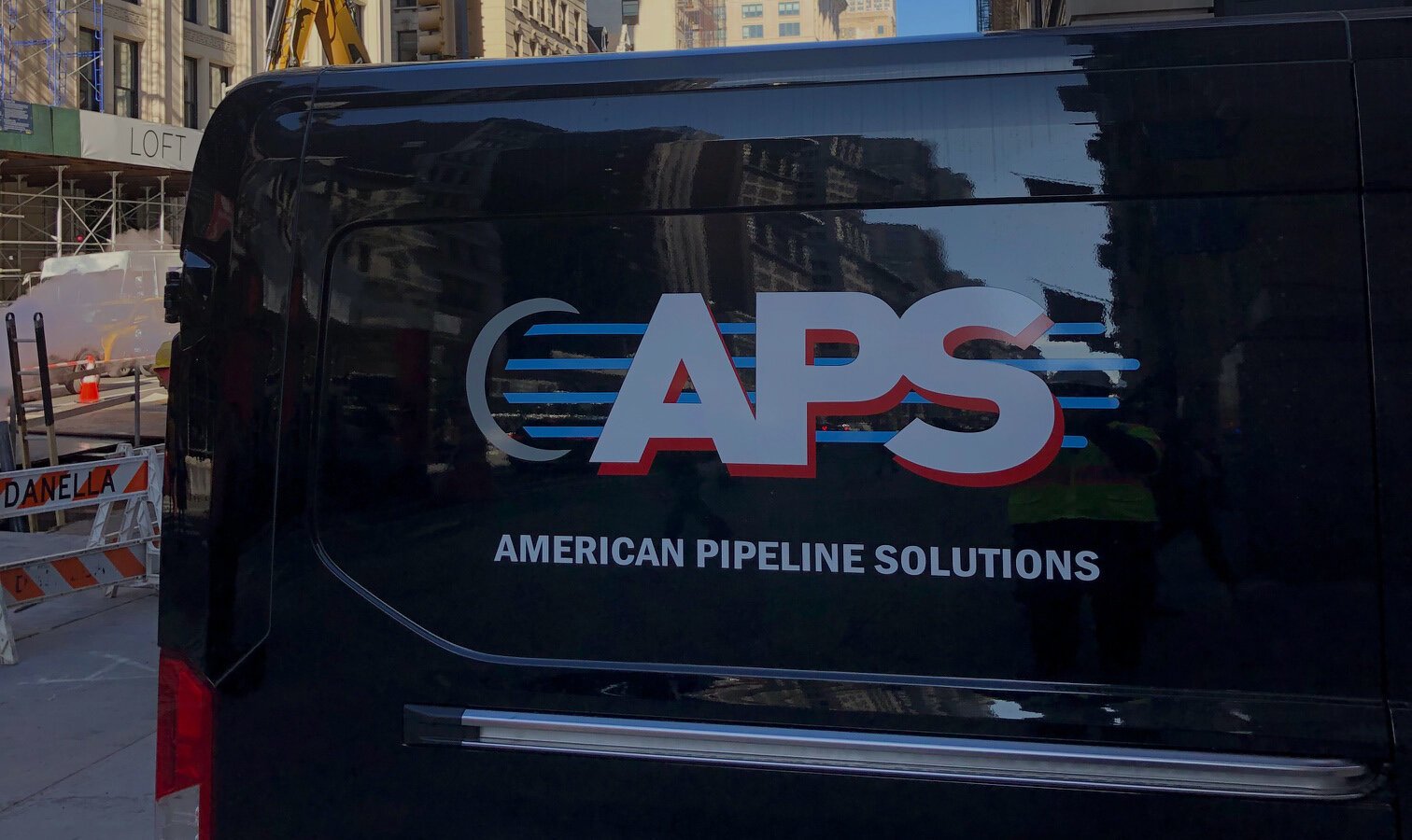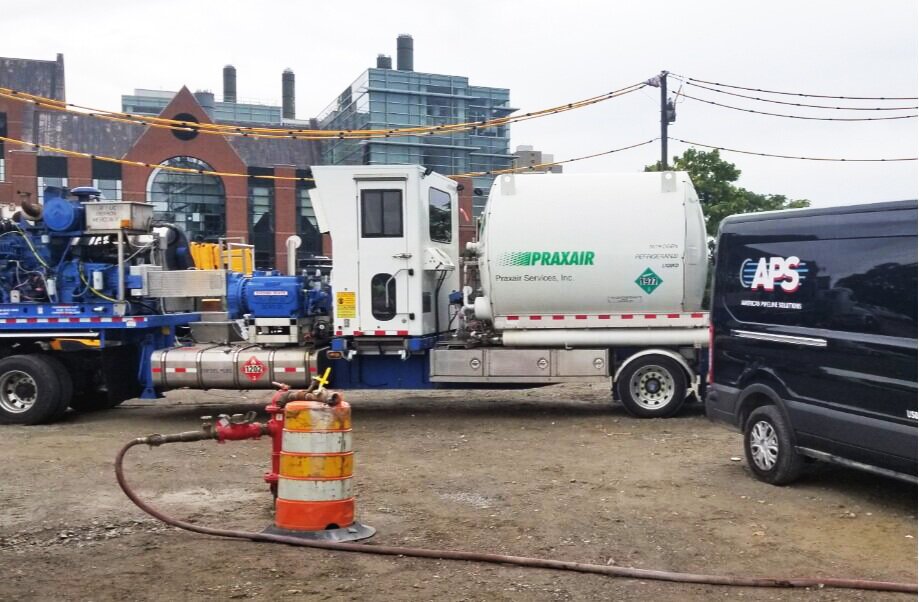
Nitrogen Pressure Testing
At American Pipeline Solutions (APS), safety and reliability are at the core of every service we provide. One of the most effective ways we help clients verify the condition of their pipelines and associated systems is through nitrogen pressure testing. This proven method uses inert nitrogen gas to pressurize pipelines and facilities, ensuring they can withstand operational pressures while also confirming the absence of leaks.
Unlike water-based testing, which can introduce moisture, corrosion, or freezing issues, nitrogen testing offers a clean, dry, and safe solution for assessing system integrity. Whether for small lines at a metering and regulating (M&R) station or larger pipeline sections where hydrostatic testing is impractical, APS technicians provide accurate, efficient nitrogen testing services that are performed to the highest safety standards
Nitrogen pressure testing is usually performed on smaller pipelines (like a M&R Station) or where the weather will adversely affect a test utilizing water. In addition to being readily available and low cost, nitrogen pressure testing also eliminates pipeline drying. APS technicians perform nitrogen pressure testing for numerous clients efficiently and safely.
What Is Nitrogen Pressure Testing?
Nitrogen pressure testing is a procedure in which compressed nitrogen gas is introduced into a pipeline or vessel at a specified pressure. The system is then monitored over a defined period to determine whether it maintains pressure consistently. If leaks are present, they are detected through visual inspection, soap-solution application, or electronic monitoring.
This process is used both during pre-commissioning—before a pipeline or facility enters service—and during ongoing maintenance programs to assess pipeline condition and reliability. By verifying that a system can hold pressure safely, nitrogen testing provides operators with confidence that their infrastructure is ready for operation and free from defects that could lead to costly downtime or safety risks.
Why Use Nitrogen Instead of Water?
Hydrostatic testing, which relies on water, is common for large pipelines. However, there are many situations where nitrogen offers significant advantages:
Cold-weather environments: Water can freeze inside the system, creating safety hazards and costly damage. Nitrogen remains stable in sub-zero conditions, making it ideal for winter testing.
Moisture-sensitive systems: Some facilities cannot risk introducing water because it could cause corrosion or contamination. Nitrogen is a dry gas that prevents these issues.
Eliminating drying time: With hydrostatic testing, water must be removed and the pipeline thoroughly dried before service. Nitrogen testing avoids this step, reducing downtime.
Cost efficiency for smaller systems: For smaller lines or components, nitrogen testing is often faster and more economical.
Because nitrogen is non-flammable, non-reactive, and widely available, it provides a safe, controlled medium for pressure testing. APS leverages these benefits to help clients streamline their commissioning and maintenance activities.
Applications of Nitrogen Pressure Testing
Nitrogen testing has a wide range of applications across industries, but it is especially valuable in the oil, gas, and utility sectors. At APS, we frequently perform nitrogen pressure testing for:
Pipeline networks: To verify system integrity before they are put into service or after modifications.
M&R stations: Where smaller-diameter lines require testing without the risk of water contamination.
Vessels and tanks: To ensure containment structures can hold operational pressures safely.
Pipeline repairs and tie-ins: After maintenance or installation, nitrogen testing confirms the success of the work before returning a system to service.
Each application requires a tailored approach, and our technicians adapt the process to meet the specific regulatory requirements and safety standards of each project.
The Nitrogen Pressure Testing Process
APS follows a structured and safety-focused process for nitrogen pressure testing. While every project has unique requirements, a typical sequence includes:
System Preparation: The pipeline or component is isolated from the rest of the system. Valves are secured, and the test section is clearly defined. Any existing gases or debris are safely purged.
Controlled Pressurization: Nitrogen gas is introduced gradually using precision regulators. We begin at low pressure to purge contaminants and confirm the system can hold pressure without immediate leaks.
Incremental Pressure Increase: Once the system passes the low-pressure stage, pressure is increased step by step until the test level—typically higher than the operating pressure—is reached.
Monitoring and Inspection: The pressure is held for the required duration, which may range from minutes to several days depending on the scope of the project. During this time, our technicians monitor gauges and inspect fittings, welds, and joints using solutions or electronic detection methods to identify leaks.
Analysis and Reporting: Results are documented carefully. If leaks are detected, the system is depressurized, repairs are made, and the test is repeated until full integrity is confirmed.
This systematic approach ensures accuracy while maintaining the highest levels of safety for personnel and the surrounding environment.
Safety Advantages of Nitrogen Testing
Pipeline testing must always balance accuracy with safety. Nitrogen offers key advantages in this regard:
Non-flammable and inert: Nitrogen does not combust, reducing risks compared to air or oxygen-based tests.
Reduced environmental impact: Unlike water, nitrogen does not require disposal or drying procedures after testing.
Personnel safety: Proper handling and monitoring ensure that nitrogen testing is a controlled and predictable process.
APS technicians are trained to manage all aspects of nitrogen testing safely. From pressure regulation to leak detection, our procedures are designed to minimize risks while delivering reliable results.
Comparing Nitrogen Testing to Hydrostatic Testing
Hydrostatic testing has long been the standard for pipeline verification, but nitrogen testing is increasingly chosen for specific conditions. The two methods differ in ways that can significantly impact project costs and timelines.
Time efficiency: Hydrostatic testing requires extensive drying after use, while nitrogen testing eliminates this step.
System protection: Nitrogen prevents moisture-related corrosion that water-based methods can introduce.
Flexibility: Nitrogen testing can be performed in environments where hydrotesting is not feasible, such as cold climates or moisture-sensitive systems.
Cost considerations: For smaller systems, nitrogen testing is often more economical, though hydrotesting may still be preferred for larger-diameter pipelines.
At APS, we work with clients to determine the most effective testing method for their project, balancing regulatory requirements, environmental factors, and budget.
The Role of Nitrogen Testing in Pipeline Condition Assessment
Beyond leak detection, nitrogen testing plays an important role in pipeline condition assessment. By verifying that a system can maintain pressure, operators gain insight into the structural integrity of their infrastructure. This information is critical for:
Extending the service life of assets
Planning maintenance schedules
Avoiding unexpected failures and costly shutdowns
Complying with regulatory standards
When combined with other inspection services, nitrogen testing provides a complete picture of pipeline performance and reliability.
Why Choose APS for Nitrogen Pressure Testing?
American Pipeline Solutions has built a reputation for delivering precision testing services with a focus on safety, compliance, and client satisfaction. When you choose APS, you benefit from:
Experienced technicians trained in industry best practices for nitrogen testing.
Advanced equipment that ensures accurate pressure control and leak detection.
Flexible service delivery, whether for small-diameter lines, large pipeline sections, or specialized facilities.
Commitment to safety, with protocols designed to protect personnel, the environment, and your assets.
Every project is handled with the same level of care, whether it involves a small station line or a critical section of transmission pipeline.
Get Started with Nitrogen Pressure Testing
Nitrogen pressure testing is a safe, efficient, and cost-effective way to confirm pipeline integrity and system readiness. At APS, we make the process straightforward by combining technical expertise with hands-on field experience.
If you need reliable testing for your pipelines, stations, or vessels, our team is ready to provide the professional support you require. Contact American Pipeline Solutions today to discuss your project and schedule a consultation.


















